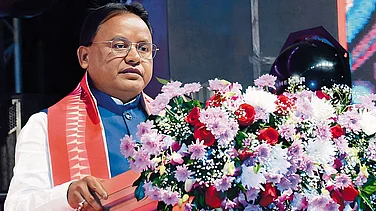A day before finance minister Nirmala Sitharaman presents the annual budget for 2022-23, the Economic Survey 2022 has projected an ambitious GDP growth rate of 8 to 8.5 per cent for the financial year 2022-23 against the current fiscal’s advance estimates of 9.2 per cent. The projected growth, if achieved, will establish India as a stable economy once again.
But, how easy will it be for the government to achieve this growth rate in the next financial year that begins in April 2022?
An Indian GDP growth rate above 8 per cent is not unheard of, but the last time India achieved that rate on the basis of a positive growth year, was in 2010-11. The current financial year’s above 9 per cent growth (advance estimate) will be achieved at a negative growth rate of 7.2 per cent in 2020-21. It means that India’s real growth in the current financial year, compared to the 2019-20 level will be under 2 per cent.
Though the projection for 2022-23 appears optimistic, it is important to understand that the government itself is wary of several factors that may act as a spoilsport. “This projection is based on the assumption that there will be no further debilitating pandemic-related economic disruption, monsoon will be normal, withdrawal of global liquidity by major central banks will be broadly orderly, oil prices will be in the range of $70-$75/bbl, and global supply chain disruptions will steadily ease over the course of the year,” reads the survey.
Between Pandemic And Expensive Oil
Even if we assume that the pandemic’s worst is over and the future waves will have minimal impact on the economic activity in the country, there are other factors that are unlikely to be positive in the near future. The government is hoping the price of crude oil to hover around $70-$75 per barrel for the entire year. “The $70-75 per barrel assumption is an average price range. Whether $90 will prevail in the new financial year is an assumption that has been made, we do not know,” said chief economic advisor V. Anantha Nageswaran.
Nageswaran’s comments give away the risk his growth estimates face from the global oil economy. Brent crude touched $90 per barrel briefly this week for the first time in years. While crude oil prices have been going up for some time, the ongoing geopolitical tension between NATO forces and the Russian army over Ukraine can take the black gold beyond $100 per barrel in the coming quarters. India imports over 80 per cent of its crude oil requirements, making it one of the most vulnerable large economies to crude price fluctuations.
According to the Reserve Bank of India, a $10 per barrel increase in crude prices leads to an additional $12.5 billion deficit, contributing to 43 basis points (bps) of India’s current account deficit (CAD) in the economy. Due to controlled crude oil prices in the international market, India’s CAD was just 0.1 per cent of GDP in the first half of 2021-22. The tables are likely to turn next year in the Indian economy, putting pressure on the government's balance of payment account.
Missing Private Consumption
The biggest cause of worry for the government and its target has to be muted private consumption in the economy. According to the Economic Survey 2022, while total consumption is estimated to have grown by 7 per cent in 2021-22, private consumption still remains below the pre-pandemic level. The government believes that it was supply-side disruptions that led to a “dip in vehicle registrations”, holding people from spending money. But FMCG companies like Marico have blamed high raw material inflation for muted consumption of their products. Given that inflation has become a global phenomenon, a by-product of pandemic stimulus provided by governments across the world, the government will have to walk a tightrope to boost consumption without fuelling inflation further in the economy.
This puts the future of India’s quest for private sector investments in limbo. The private sector Capex cycle has remained muted throughout the last decade because there was not enough demand from the private sector. While the government has made up for it by investing heavily in the economy year after year, this peculiar situation has created the problem of jobless growth in the Indian economy, where people only associated with the government sector contribute to the consumption cycle.
If the government wants its production link incentive scheme to be successful in the long run, it will need to find a way to boost private consumption at the earliest. Will Nirmala Sitharaman’s Union Budget 2022 address this issue?































